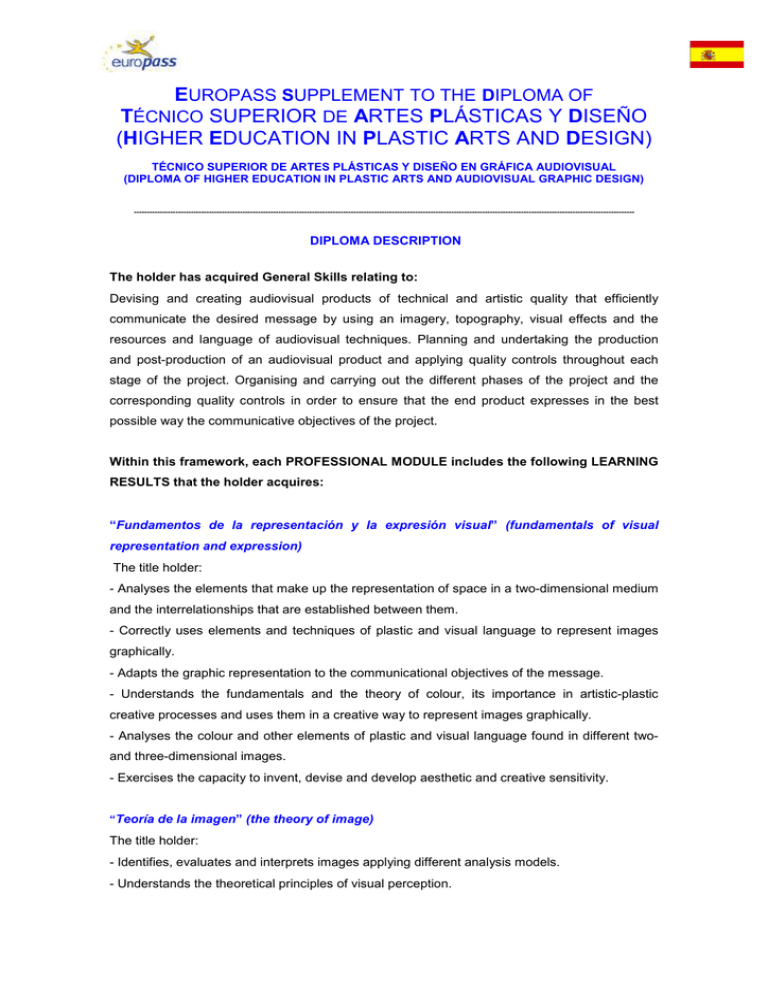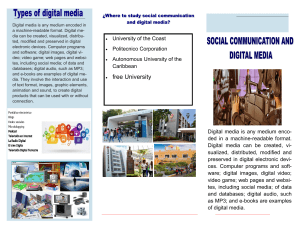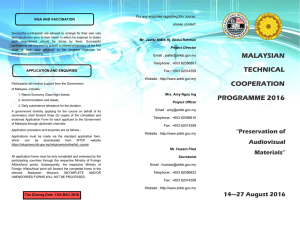diploma - Ministerio de Educación, Cultura y Deporte
Anuncio

EUROPASS SUPPLEMENT TO THE DIPLOMA OF TÉCNICO SUPERIOR DE ARTES PLÁSTICAS Y DISEÑO (HIGHER EDUCATION IN PLASTIC ARTS AND DESIGN) TÉCNICO SUPERIOR DE ARTES PLÁSTICAS Y DISEÑO EN GRÁFICA AUDIOVISUAL (DIPLOMA OF HIGHER EDUCATION IN PLASTIC ARTS AND AUDIOVISUAL GRAPHIC DESIGN) -------------------------------------------------------------------------------------------------------------------------------------------------------------------------------------------------- DIPLOMA DESCRIPTION The holder has acquired General Skills relating to: Devising and creating audiovisual products of technical and artistic quality that efficiently communicate the desired message by using an imagery, topography, visual effects and the resources and language of audiovisual techniques. Planning and undertaking the production and post-production of an audiovisual product and applying quality controls throughout each stage of the project. Organising and carrying out the different phases of the project and the corresponding quality controls in order to ensure that the end product expresses in the best possible way the communicative objectives of the project. Within this framework, each PROFESSIONAL MODULE includes the following LEARNING RESULTS that the holder acquires: “Fundamentos de la representación y la expresión visual” (fundamentals of visual representation and expression) The title holder: - Analyses the elements that make up the representation of space in a two-dimensional medium and the interrelationships that are established between them. - Correctly uses elements and techniques of plastic and visual language to represent images graphically. - Adapts the graphic representation to the communicational objectives of the message. - Understands the fundamentals and the theory of colour, its importance in artistic-plastic creative processes and uses them in a creative way to represent images graphically. - Analyses the colour and other elements of plastic and visual language found in different twoand three-dimensional images. - Exercises the capacity to invent, devise and develop aesthetic and creative sensitivity. “Teoría de la imagen” (the theory of image) The title holder: - Identifies, evaluates and interprets images applying different analysis models. - Understands the theoretical principles of visual perception. - Interprets the meaningful codes of an image. - Identifies and evaluates the expressive function of an image in its context. - Identifies and analyses communication strategies in an image. - Understands the different production areas and scenarios of fixed and moving images. “Medios informáticos” (IT media) The title holder: - Analyses the evolution of IT media in today's society and the presence of new technologies with which to create and edit animated images. - Understands IT fundamentals, the relationship between hardware and software and their characteristics and functions. - Understands and applies the fundamental concepts of digital vectorial images and bitmap images, the treatment of digital typography, colour systems and the right formats for each requirement. - Digitalizes images, stores them and converts them to appropriate formats. - Understands and uses applications found in specific IT design programmes. - Uses IT media as instruments for devising, managing and communicating his or her own work. “Fotografía” (photography) The title holder: - Understands and masters photographic technique and technology. - Understands photographic language, its dimensions and particularities. - Uses photography in his or her own audiovisual graphic projects. - Knows how to handle photographic images suitable for audiovisual graphic projects. “Historia de la imagen audiovisual y multimedia” (history of audiovisual and multimedia image) The title holder: - Knows the origins of moving images and their conceptual, aesthetic and technical evolution. - Understands the language and the distinctive features of the different media and manifestations of audiovisual communication. - Knows the historic, formal and technological evolution of audiovisual and multimedia media and identifies the main production centres, authors and works. - Typifies the different manifestations of audiovisual communication and their evolution in relation to the aesthetic concepts of the historic-artistic context. - Connects the evolution of audiovisual media and techniques and new technologies with the formal and aesthetic aspects of audiovisual and multimedia images. - Analyses and evaluates audiovisual and multimedia products in their technological, artistic, communicative and expressive dimensions. - Assesses current audiovisual and multimedia images on the basis of historical-artistic knowledge, and with his or her own taste and sensitivity. “Recursos gráficos y tipográficos” (graphic and typographic resources) The title holder: - Identifies and analyses the communicative and expressive graphic design resources in its different areas. - Knows how to use composition, typography, colour and images to communicate messages and ideas in audiovisual media. - Analyses the formal and functional characteristics of typography and typographic composition. - Explores the communicative possibilities of typographic elements in efficiently transmitting messages and ideas in audiovisual media. - Knows how to structure media and how to order the elements that form part of the graphic discourse, bearing in mind the communicational objectives of the task. - Assesses the particularities of audiovisual media in relation to the expressive and communicative possibilities of the graphic resources. “Técnicas 3D” (3D techniques) The title holder: - Understands the fundamentals of 3D techniques and how they are applied to audiovisual media. - Knows the image formats and the audiovisual sequences that are dedicated to different media: applications used in virtual set design, video, cinema, video games, Internet and others, and knows how to interconnect the formats to and among the different applications. - Masters modelling techniques, materials, textures and lighting and creates virtual spaces. - Applies 3D digital techniques in graphic advertising case studies. - Uses special effects editing software in graphic advertising case studies. “Guión y estructura narrativa” (script and narrative structure) The title holder: - Knows and uses the lexicon and codes of graphic narrative. - Masters the language, structure and use of script in graphic narrative. - Identifies the narrative structure of a story and proposes various solutions involving graphic organisation for the audiovisual medium. - Creates proposals for graphic narratives for audiovisual products based on his or her own or third-party stories. - Knows how to develop a narrative script paying special attention to the distinctive features of the audiovisual format. “Lenguaje y tecnología audiovisual” (audiovisual language and technology) The title holder: - Understands the evolution and the language of moving images and analyses the codes and dimensions of audiovisual language. - Knows the syntaxes and the semantics of multimedia image, the unique characteristics of audiovisual media and how they differ from other media. - Explores the expressive and artistic possibilities of the audiovisual narrative and applies them when creating audiovisual works. - Handles basic technology for creating audiovisual products. - Analyses and evaluates audiovisual products and issues a critical documented opinion as to his or her audiovisual creation and that of others. - Interprets graphic projects in the audiovisual medium and plans production phases. - Correctly uses terminology that is appropriate to the subject. - Develops his or her own audiovisual communication capacity, invention and eloquence. ”Proyectos de gráfica audiovisual” (audiovisual graphic projects) The title holder: - Knows the particularities of how to create, manage and transmit corporate images in on television. - Knows the expressive resources and strategies when carrying out graphic audiovisual case studies: computer graphics, cinema graphics, video, television, video games and new media. - Plans and develops the design process for audiovisual graphic products and carries out the quality controls that make it possible to solve such technical, artistic and communication problems that may arise. - Uses the distinctive features of audiovisual graphic language, image, typography, movement, sound, space, time and its main discursive structures when carrying out audiovisual graphic case studies. - Masters and uses the technologies, cameras and sound-recording equipment when developing audiovisual graphic products with the level of quality expected in the professional world. - Correctly plans the execution of the different phases of an audiovisual graphic project and develops it until he or she obtains an end product of technical, artistic and communicative quality. - Evaluates the execution of audiovisual works as an opportunity to experiment, create and communicate and for personal artistic expression. - Begins searching for his or her own aesthetic style and discourse with which to communicate ideas and messages through audiovisual works. - Issues a critical and documented opinion of his or her own work and the results obtained. - Knows the specific regulations that apply to audiovisual graphic. “Proyecto integrado” (integrated project) The title holder: - Proposes and carries out an audiovisual graphic project of technical, artistic and communicational quality. - Undertakes the project carrying out all the stages and the corresponding quality controls. - Develops, by projecting and carrying out an original audiovisual graphic project, the professional skills. “Formación y orientación laboral“ (training and career guidance) The title holder: - Analyses and interprets the legal working framework and knows the rights and obligations that derive from labour relations. - Understands the legal requirements and conditioning factors for organizing and running a small or medium-size company, taking into account production, legal, mercantile and social occupational factors. - Identifies the different ways by which to enter the labour market and lifelong training, and knows the institutional bodies, both national and community, that are dedicated to this end. - Understands and applies occupational health and safety standards and becomes aware of the need to protect the environment, as factors that determine the quality of life. “Prácticas en empresas, estudios o talleres” (practical training in companies, studios or workshops) The title holder: - Knows the day-to-day working routines of an audiovisual company or communication studio. - Carries out the professional tasks that correspond to his or her level of training. - Enters into contact with the working world and the company's social, working and technical systems. - Contrasts the knowledge, training and skills acquired in the educational centre with the industry's corporate and working reality. - Incorporates into their training knowledge relating to the work environment in the audiovisual field, the market situation and market relationships, artistic and cultural tendencies, how work is organised and coordinated, corporate management, social - occupational relationships within the company, etc., all of which is needed when setting out on a career. - Acquires technical knowledge of specialized tools, instruments, materials and machinery. - Actively participates in the audiovisual production and editing phases under the guidance of the corresponding tutor or coordinator. - Applies the knowledge, skills and abilities acquired during the theoretical and practical training period provided by the educational centre. THIS DIPLOMA OPENS DOORS TO THE FOLLOWING JOBS The Holder of a Diploma of Higher Education in Plastic Arts and Audiovisual Graphic Design carries out his or her activity as a self-employed professional, an associate or as an employed person. As a specialist professional, he or she creates, whether in part or entirely, audiovisual pieces for the audiovisual service and production sector, for corporative graphic identity and for TV programme and/or channel titles and for other institutions and/or products that may require such work. He or she draws up audiovisual graphic proposals and projects ordered by companies, design studios or public bodies. He or she may work independently or as an employee, interpreting the ideas of other professionals through scripts or storyboards. The following are the most relevant occupations and jobs: • Audiovisual production and post-production aimed at different distribution formats and technical media: cinema, television, websites, multimedia, video games, mobile telephones and other media, employing standard industry software. • Design and creation of real and virtual scenery and scenic lighting. • Musical and soundtrack selection for audiovisual works. • Audiovisual production of corporate graphics for TV stations, programmes, institutional messages, products, services and others. • Design the graphic representation of information for audiovisual media. • Audiovisual labelling. • Digital post-production. • Specialist collaboration in audiovisual production in multidisciplinary teams. DIPLOMA ISSUANCE, ACCREDITATION AND LEVEL Body that issues the Diploma in the name of the King: The Ministerio de Educación, Cultura y Deporte (the Ministry of Education, Culture and Sport) or the autonomous communities in the area of their own administrative responsibility. The degree has academic and professional effects that are valid throughout the entire State. Official duration of the Diploma: 2,000 hours. Level of the Diploma (national or international). • NATIONAL: Non-university higher education. • INTERNATIONAL: • Level 5b of the International Standard Classification of Education (ISCED5b). • Level 5 of the European Qualifications Framework (EQF5). Access requirements: Bachelor’s Degree or Certificate of having passed the corresponding access test and the specific access test. Access to the next level of education or training: It is possible to move on to higher education in artistic teaching and to any university degree course. Legal basis. Rules and regulations on which the Diploma is based: • Royal Decree 1430/2012, of 11 October, which establishes the Diploma of Higher Education in Plastic Arts and Audiovisual Graphic Design which belongs to the professional artistic family of Graphic and Audiovisual Communication and approves the corresponding minimum education requirements. Explanatory note: This document is intended as supplementary information to the Diploma in question, but on its own it does not have any legal validity. TRAINING FOR THE OFFICIALLY RECOGNIZED DIPLOMA PROFESSIONAL MODULES OF THE DIPLOMA ESTABLISHED IN THE ROYAL DECREE ECTS CREDITS Fundamentals of visual representation and expression 5 The theory of image 3 IT media 5 Photography 3 History of Audiovisual and Multimedia Image 3 Graphic and Typographic Resources 4 3D techniques 5 Script and narrative structure 3 Audiovisual language and technology 9 Audiovisual graphic projects 13 Integrated project 7 Training and career guidance 3 Practical training in companies, studios or workshops 3 TOTAL CREDITS TOTAL MINIMUM EDUCATION REQUIREMENTS OFFICIAL DURATION OF THE DIPLOMA 120 2,000 * The minimum education requirements reflected in the above table constitute 55% of the total duration of the Diploma; they are of an official nature and are valid throughout the national territory. The remaining 45% is specific to each Autonomous Community and may be reflected in Annex I of this supplement. INFORMATION ABOUT THE EDUCATION SYSTEM


